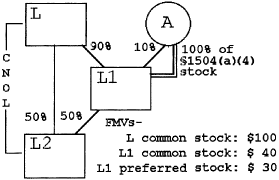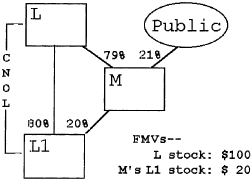TREASURY REGULATIONS
Reg. 1.1502-93A
Consolidated section 382 limitation (or subgroup section 382 limitation) generally applicable for testing dates before June 25, 1999
January 14, 2024
Treas. Reg. § 1.1502-93A. Consolidated section 382 limitation (or subgroup section 382 limitation) generally applicable for testing dates before June 25, 1999
(a) Determination of the consolidated section 382 limitation (or subgroup section 382 limitation)—(1) In general. Following an ownership change, the consolidated section 382 limitation (or subgroup section 382 limitation) for any post-change year is an amount equal to the value of the loss group (or loss subgroup), as defined in paragraph (b) of this section, multiplied by the long-term tax-exempt rate that applies with respect to the ownership change, and adjusted as required by section 382 and the regulations thereunder. See, for example, section 382(b)(2) (relating to the carryforward of unused section 382 limitation), section 382(b)(3)(B) (relating to the section 382 limitation for the post-change year that includes the change date), section 382(m)(2) (relating to short taxable years), and section 382(h) (relating to recognized built-in gains and section 338 gains).
(2) Coordination with apportionment rule. For special rules relating to apportionment of a consolidated section 382 limitation (or a subgroup section 382 limitation) when one or more corporations cease to be members of a loss group (or a loss subgroup) and to aggregation of amounts so apportioned, see § 1.1502-95A(c).
(b) Value of the loss group (or loss subgroup)—(1) Stock value immediately before ownership change. Subject to any adjustment under paragraph (b)(2) of this section, the value of the loss group (or loss subgroup) is the value, immediately before the ownership change, of the stock of each member, other than stock that is owned directly or indirectly by another member. For this purpose—
(i) Ownership is determined under § 1.382-2T;
(ii) A member is considered to indirectly own stock of another member through a nonmember only if the member has a 5-percent or greater ownership interest in the nonmember; and
(iii) Stock includes stock described in section 1504(a)(4) and § 1.382-2T(f)(18)(ii) and (iii).
(2) Adjustment to value. The value of the loss group (or loss subgroup), as determined under paragraph (b)(1) of this section, is adjusted under any rule in section 382 or the regulations thereunder requiring an adjustment to such value for purposes of computing the amount of the section 382 limitation. See, for example, section 382(e)(2) (redemptions and corporate contractions), section 382(l)(1) (certain capital contributions) and section 382(l)(4) (ownership of substantial nonbusiness assets). The value of the loss group (or loss subgroup) determined under this paragraph (b) is also adjusted to the extent necessary to prevent any duplication of the value of the stock of a member. For example, the principles of § 1.382-8 (relating to controlled groups of corporations) apply in determining the value of a loss group (or loss subgroup) if, under § 1.1502-91A(g)(2), members are not included in the determination whether the group (or loss subgroup) has a net unrealized built-in loss.
(3) Examples. The following examples illustrate the principles of this paragraph (b).
(a) L, L1, and L2 compose a loss group. L has outstanding common stock, the value of which is $100. L1 has outstanding common stock and preferred stock that is described in section 1504(a)(4). L owns 90 percent of the L1 common stock, and A owns the remaining 10 percent of the L1 common stock plus all the preferred stock. The value of the L1 common stock is $40, and the value of the L1 preferred stock is $30. L2 has outstanding common stock, 50 percent of which is owned by L and 50 percent by L1. The L group has an ownership change. The following is a graphic illustration of these facts:

(b) Under paragraph (b)(1) of this section, the L group does not include the value of the stock of any member that is owned directly or indirectly by another member in computing its consolidated section 382 limitation. Accordingly, the value of the stock of the loss group is $134, the sum of the value of—
(1) The common stock of L ($100);
(2) the 10 percent of the L1 common stock ($4) owned by A; and
(3) The L1 preferred stock ($30) owned by A.
(a) L and L1 compose a consolidated group. L's stock has a value of $100. L owns 80 shares (worth $80) and corporation M owns 20 shares (worth $20) of the L1 stock. L also owns 79 percent of the stock of corporation M. The L group has an ownership change. The following is a graphic illustration of these facts:

(b) Under paragraph (b)(1) of this section, because of L's more than 5 percent ownership interest in M, a nonmember, L is considered to indirectly own 15.8 shares of the L1 stock held by M (79% × 20 shares). The value of the L loss group is $104.20, the sum of the values of—
(1) The L stock ($100); and
(2) The L1 stock not owned directly or indirectly by L (21% × $20, or $4.20).
(c) Recognized built-in gain of a loss group or loss subgroup. If a loss group (or loss subgroup) has a net unrealized built-in gain, any recognized built-in gain of the loss group (or loss subgroup) is taken into account under section 382(h) in determining the consolidated section 382 limitation (or subgroup section 382 limitation). See § 1.1502-99A(a)(2) for a special rule relating to the application of § 1.502-93(c)(2) to consolidated return years for which the due date of the return is after June 25, 1999.
(d) Continuity of business—(1) In general. A loss group (or a loss subgroup) is treated as a single entity for purposes of determining whether it satisfies the continuity of business enterprise requirement of section 382(c)(1).
(2) Example. The following example illustrates the principle of this paragraph (d).
L owns all the stock of two subsidiaries, L1 and L2. The L group has an ownership change. It has pre-change consolidated attributes attributable to L2. Each of the members has historically conducted a separate line of business. Each line of business is approximately equal in value. One year after the ownership change, L discontinues its separate business and the business of L2. The separate business of L1 is continued for the remainder of the 2 year period following the ownership change. The continuity of business enterprise requirement of section 382(c)(1) is met even though the separate businesses of L and L2 are discontinued.
(e) Limitations of losses under other rules. If a section 382 limitation for a post-change year exceeds the consolidated taxable income that may be offset by pre-change attributes for any reason, including the application of the limitation of § 1.1502-21(c) or 1.1502-21T(c) in effect prior to June 25, 1999, as contained in 26 CFR part 1 revised April 1, 1999, as applicable, the amount of the excess is carried forward under section 382(b)(2) (relating to the carryforward of unused section 382 limitation).
The preliminary Code is a preliminary release of the Internal Revenue Code of 1986 (the "Code") by the Office of the Law Revision Counsel and is subject to further revision before it is released again as a final version. The source of the preliminary Code used in TouchTax is available here: https://uscode.house.gov/download/download.shtml. The Code is a consolidation and codification by subject matter of the general and permanent laws of the U.S. prepared by the Office of the Law Revision Counsel of the U.S. House of Representatives. The Treasury Regulations are a codification of the general and permanent rules published in the Federal Register by the departments and agencies of the federal government. The version of the Treasury Regulations available within TouchTax is part of the Electronic Code of Federal Regulations which is not an official legal edition of the Code of Federal Regulations but is an editorial compilation of CFR material and Federal Register amendments produced by the National Archives and Records Administration's Office of the Federal Register (OFR) and the Government Publishing Office. The source of the CFR used in TouchTax is available here: https://www.govinfo.gov/bulkdata/ECFR/title-26. Those using TouchTax for legal research should verify their results against the printed versions of the Code and Treasury Regulations. TouchTax is copyright 2024 by Com-Lab (Mobile). Learn more at http://touchtax.edrich.de.